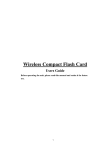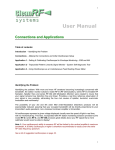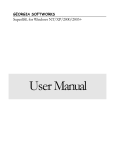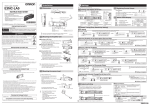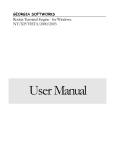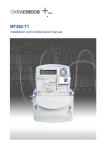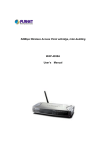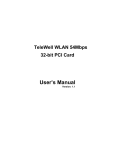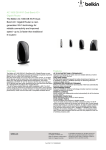Download User's Manual of 2511CF
Transcript
Wireless Compact Flash Card Users Guide Before operating the unit, please read this manual and retain it for future 1 Contents Introduction ........................................................................................3 Features and Benefits ...................................................................3 Wireless Solutions and Application..............................................4 Package Contents .........................................................................4 System Requirements ...................................................................4 Ins talling Setup Utilit y of Wireless LAN Compact Flas h Card ..........5 Wireless LAN Setting..........................................................................9 Us ing the Wireless LAN Utility .........................................................12 Specification......................................................................................17 Appendix A .......................................................................................19 Network Topology ......................................................................19 Appendix B ....................................................................................... 22 2 In troduction This product is an IEEE 802.11b Wireless Compact Flash Adapter that uses a standard Type I CF adapter interface which integrated with wireless LAN technology. It provides an easy and fast way to access the Internet via wireless network. This Wireless Compact Flash adapter allows the users to install on PDAs (Personal Digital Assistants), Pocket/Handheld PCs and other devices equipped with a Type I CF slot. This Compact Flash Card is 802.11b compliant and the data rate of connection is up to 11Mbps. With an 802.11b Compact Flash Card you can send and receive E- mail, synchronize with your desktop computer, and surf the Internet while on the move. Features and Benefits 11Mbps data transfer rate IEEE 802.11b compliant High-speed data transmission Fully interoperable with IEEE802.11b compliant products Automatic data rate scaling at 11, 5.5, 2 and 1 Mbps Optimized throughput, range and connectivity Wired Equivalent Privacy (WEP) encryption and decryption support Powerful data security at 64 and 128 bits Supports a variety of popular computing devices Compact Flash Type-I standard such as PDA, Pocket PC, Tablet PC, Webpad and Handheld device Supports both Pocket PC and Flexible to work with both your PDA and your Windows PC operating systems notebook PC Wide coverage range up to 300 meters in open space Wireless connectivity for all your computers Advanced Power Management and Suspend on WLAN Very low power consumption delivers extended battery life for client devices Plug and Play Compact Flash Type-I interface Easy installation Significantly improved indoor multipath distortion Seamless roaming Higher link quality in indoor environment Full mobility Direct Sequence Spread Spectrum Provides robust, interference-resistant, and secure (DSSS) technology wireless connection 3 Wireless Solutions and Application Access existed networks for mobile workers Allow doctors, nurses, sales access their database while keeping mobility in the hospitals, retail stores, office campus or other buildings. Difficult-to-wire environment There are many situations where wires cannot or cannot easily be laid. Historic buildings, older buildings, open areas and across busy streets make the installation of LANs either impossible or very expensive. Frequently changed environment Show rooms, meeting rooms, retail stores, and manufactur ing sites where the workplace located are frequently rearranged. Wired LAN backup Network managers implement wireless LANs to provide backup for mission-critical applications running on wired networks. Wireless extensions to wired networks Network managers in dynamic environments can minimize the overhead caused by moves, extensions to networks, and other changes with wireless LANs. Temporary workgroup Trade shows, exhibitions, and construction sites that require a temporary network. Retailers, airlines, and shipping companies need additional workstations during peak periods. Small Office/ Home Office (SOHO) Networks SOHO users need a cost-effective, easy and quick installation of a small network. Package Contents Ÿ Ÿ Ÿ Compact Flash Card Unit Installation CD (Include User’s Manual, Acrobat® Reader and Packet PC Utility Program) Quick Installation Guide System Requirements For using this Compact Flash Card, the following requirements are needed: Ÿ A Handheld/Pocket PC running Windows CE 3.0 with an available Compact Flash Type I slot. Ÿ A computer which uses Windows 95/98/ME/2000/XP operating system has an ActiveSync program to connect with the Pocket PC 4 In stalling Setup Utility of Wireless LAN Compact Flash Ca rd 1. Create a connection between Hand PC and Desktop/Laptop by Microsoft Active Sync. 2. Install the PDA’s driver and utility by executing CFDR.exe as shown in Figure1 and Figure 2. Figure 1 Figure 2 5 3. After the Install Shield Wizard window appears, click Next to continue as shown in Figure3. Figure 3 4. In the Software License Agreement dialog window, click Yes to accept all the terms of the License Agreement as shown in Figure4. Figure 4 6 5. Click Yes to install the driver in the default install directory as shown in Figure 5, then click OK to continue the setup procedure as shown in Figure 6. Figure 5 Figure 6 6. Click Finish to complete the setup procedure. Figure 7 NOTE: Insert the Wireless Compact Flash card to the PDAs AFTER the Setup Utility and Driver ’s installation procedure. 7 7. Start the Microsoft ActiveSync to check the installation status of the PDAs. In the Microsoft ActiveSync dialog window, click Tools and then choose Add/ Remove Programs to check out the drivers or programs that has been installed as shown in Figure 8. Figure 8 8 Wireless LAN Setting 1. Connect the wireless compact flash card to PDAs. 2. Select StartàSettings on the handheld. In the Settings dialog, click Connections and then click Network icon as shown in Figure 9. Figure 9 3. In the Adapter tab, choose 802.11b WLAN 11Mbps Wireless LAN PC to set up the IP address as shown in Figure 10. Figure 10 9 4. In the IP Address label, choose Use server-assigned IP address if there is a DHCP server in your own network as shown in Figure 11. Figure 11 5. In the IP Address label, choose Use specific IP address if you need to set up the fix IP address as shown in Figure 12. Figure 12 10 6. After the setting of Step 5, move to Name Servers to set up the DNS server as shown in Figure 13. Figure 13 7. Choose Use proxy server in the Connections tab of the Internet Explorer’s options as shown in Figure 14 when you connect Internet via Proxy Server. Figure 14 11 Using the Wireless LAN U tility This Wireless Compact Flash Adapter is a “ready-to-use” device. The default settings have finished for a typical Infrastructure Wireless LAN. After installing the Setup Utility and the Driver into the handheld devices, simply install the Wireless LAN Compact Flash Card onto your handheld devices and it is ready to use. In some situations, however, you may want to adjust the configuration settings to manage your wireless network. The Wireless LAN Utility of this Compact Flash Card provides you to make the configuration changes by an easily interface. If you need to adjust the settings, please following the instructions below. Status State This item shows status information about the radio link as shown in Figure 15. Ÿ Associated BSSID – means the wireless client is connected to an access point. BSSID is shown in the form of six hex digits which is the MAC address of the access point. Ÿ Scanning – means the wireless client is searching for an available access point in infrastructure mode. Ÿ Disconnected – means there are no access points or other wireless clients (if communicating in Ad-hoc mode), or the PC Card is unplugged in your computer. Current Tx Rate (Mbits/s) The data speed that wireless client is transmitting. Figure 15 Current Channel The operation radio frequency channel that wireless client is using in infrastructure mode. In infrastructure mode, wireless client will always go the same channel as their Access Point. Throughput (Bytes/sec) Tx: shows the outgoing (sent) data speed. Rx: shows the incoming (received) data speed. 12 Link Quality In infrastructure mode, this bar displays the transmission quality between a WLAN station (Access Point) and Wireless LAN PC Card. In Peer-to-Peer mode (Ad-Hoc), this bar displays the link quality between two Wireless LAN PC Cards. Signal Strength This bar displays the signal strength level. The higher bar is, the more powerful radio signal is received by the PC Card. Disable/Enable Radio This button is used like a switch that allows users to turn off the wireless radio by clicking this button and turn it on again. Rescan The radio will rescan all available channels by pressing this button. You can push this button to rescan the channels for better link quality when the link quality is poor. Configuration Make configuration changes by specifying the proper configuration parameters on this configuration tab as shown in Figure 16. Profile You can give a name for this field to a setting of configuration parameters, such as Network Name, Network Type, Transmit Rate, Encryption (WEP Security), etc. It makes much easier for users to change WLAN configuration settings who need to switch working places frequently. Suppose that a user has to work between the two different offices where there are different network settings. In this case, this user just needs to setup two profiles for the two offices and simply selects the proper profile when the user switches to the different office. Figure 16 Network Name For infrastructure mode, you need to type in the SSID of the access point to which your computer connects. For Ad-Hoc (peer-to-peer) mode, you need to type in the virtual SSID of the Ad-Hoc network to which your computer attaches. Network Type There are two types of network modes in this drop-down list, Peer-to-Peer and Access Point (Infrastructure). 13 Ÿ Peer to Peer: If two or more stations exchange data directly without an access point, you need to select Peer-to-Peer mode. Each station in a Peer-to-Peer (Ad-Hoc) network must specify the same network name (SSID) and peer-to-peer channel. Ÿ Access Point: If at least one access point involves in the communications in a group of stations, you need to select Infrastructure mode. Each station needs to specify the same network name (SSID) as the access point. Peer-to-Peer Channel This option is just for Peer-to-Peer (Ad-Hoc) mode. You need to specify a channel on which the communications are established. Each station in a Peer-to-Peer (Ad-Hoc) network must specify the same channel and network type (SSID). Power Save Mode Power Save function as shown in Table 1 .This function can conserve more battery energy and extend the battery life. This function has three options for power save mode. Below is detailed description. On: Off: Auto: Enable Power Save function. Disable Power Save function. Utility will automatically detect what kind of power supply a machine uses and then determine to enable or disable Power Save function. If device uses battery, Power Save Mode is set to on. If device uses AC Power, Power Save Mode is set to off. Table 1 Transmit Rate The transmission rate on which the data packets are transmitted by the client can be specified in this drop-down list as shown in Table 2. Below are the available transmission rates. Full Automatic 11 Mbps 5.5 Mbps Auto 1 or 2 Mbp PC Card chooses the highest available transmission rate allows only 11 Mbps operation allows only 5.5 Mbps operation allows only 1 or 2 Mbps operation Table 2 14 Defaults Once this button is pressed, all the settings will be set back to the default settings. Encryption Encryption is designed to make the data transmission more secure. you can select 64 or 128-bit WEP (Wired Equivalent Privacy) key to encrypt data (Default setting is Disable). WEP encrypts each frame transmitted from the radio using one of the Keys from this panel. When you use WEP to communicate with the other wireless clients, all the wireless devices in this network must have the same encryption key or passphrase . Encryption (WEP) Choose one of the encryption key (64 bit or 128bit) from the Encryption (WEP Security) drop-down list to create encryption key. Click either on Create Keys Manually radio button or on Create Keys with Passphrase radio button. There are two ways, Alphanumeric and Hexadecimal, to set the different characters as shown in Table 3. Create Keys Manually: Alphanumeric Type 5/13 alphanumeric characters in the key field Create Keys Manually: Hexadecimal Type a 10/26 hexadecimal numbers (1-9; A-F) in the key field Figure 17 Use WEP Key This drop-down list allows you to specify which of the four encryption keys that you want to use. Create Keys with Passphrase Type a character string in the field Passphrase. Data Mode 64 bit 128 bit Alphanumeric Hexadecimal 5 13 10 26 Table 3 15 Disabled Select Disabled item in the Encryption (WEP ) drop-down list allows you to disable the encryption function. Site Survey Browse the available access points in your network environment by clicking the Scan button and make a connection to one of them by pushing the Connect button in the Site Survey tab as shown in Figure 18. Figure 18 About About tab shows the product/driver/utility/PC Card firmware version as shown in Figure 19. Users have to use this version number when reporting their problems to technical support. Figure 19 16 Specifica tion General Radio Data Rate 11, 5.5, 2 and 1 Mbps, Auto Fall- Back 11 Mbps –150m 5.5 Mbps –200m Range (open environment) 2 Mbps – 300m 1 Mbps –400m Operating Voltage Regulation Certifications 3.3V FCC Part 15/UL, ETSI 300/328/CE Compatibility Fully interoperable with IEEE802.11b compliant products LED Indicator RF Link activity Network Information Network Architecture Support ad-hoc, peer-to-peer networks and infrastructure communications to wired Ethernet networks via Access Point Driver Software Support Access Protocol Windows XP/ME/2000/98/CE 3.0/PocketPC 2002 CSMA/CA Roaming IEEE802.11b compliant Security 64/128-bit WEP data encryption Radio Frequency Range U.S., Europe and Japan product covering 2.4 to 2.484 GHz, programmable for different country regulations Radio Type Modulation Direct Sequence Spread Spectrum (DSSS) CCK (11, 5.5Mbps) DQPSK (2Mbps) DBPSK (1Mbps) Operation Channels 11 for North America, 14 for Japan, 13 for Europe, 2 for Spain, 4 for France RF Output Power 13dBm Antenna Integrated, with built- in diversity Sensitivity @FER=0.08 11 Mbps <-85dbm ; 5.5 Mbps <-87dbm 2 Mbps <-89dbm ; 1 Mbps <-91dbm 17 Environmental Temperature Range Humidity -10°C to 50°C (14°F to 122°F)-operating -30°C to 80°C (-22°F to 176°F)-storage 95% maximum non condensing Physical Specifications Form Factor Dimensions Fits Compact Flash Type-I Slots 55.4(L) mm x 42.8(W) mm x 3.3(H) mm 2.18(L) in x 1.69(W) in x 0.13(H) in Weight 45.36 g/ 1.6oz 18 Appendix A Network Topology To better understand how the wireless LAN products work together to create a wireless network, it might be helpful to depict a few of the possible wireless LAN USB Adapter network configurations. The wireless LAN products can be configured as: 1. Ad-hoc (or peer-to-peer) for departmental or SOHO LANs. 2. Infrastructure for enterprise LANs. 3. IP Sharing for 56K/ISDN TA/Cable/DSL Modem – Connect Internet and your SOHO network. Ad-Hoc Wireless Network Laptop with Wireless LAN Card PDA with CF Card Desktop with Wireless USB Adapter Ad-Hoc Wi reless LAN Desktop with Wireless USB Adapter PDA with CF Card Laptop with Wireless LAN Card 1 An Ad-Hoc wireless LAN is a group of computers as well as PDAs that are equipped with a wireless adapter, connected as an independent wireless LAN (Local Area Network). NOTE: Must configure all wireless devices in the same Radio Cha nnel, SSID and Encryption Key (if WEP is enabled). 19 Infrastructure Wireless Network Internet PC Server Wireless Broadband Router/ AP Desktop with Wireless USB Adapter PDA with CF Card Laptop with Wireless LAN Card All of the Senao’s wireless devices provide access to a wired LAN through the wireless extension of the local network. An integrated wireless and wired LAN by using the Access Points is called an Infrastructure configuration. Infrastructure configuration allowed users extend the accessibility of the wireless and wired LAN. Multiple 802.11b Access Points will allow roaming and will increase the effective transmission range. 20 Roaming Internet PC Server Access Point/Router Access Point/Router Access Point/Router Wireless device roams Mobile Device between APs while maintaining uniterrupted Mobile Device network connectivity The mobile client will connect to any 802.11b AP that is within range. Each 802.11b Access Point within a roaming network must have a unique Channel and the same SSID and Encryption Keys (if WEP is enabled). 802.11b products can use three non-overlapping Channels within the same vicinity (Channels 1, 6, and 11 are non-overlapping). Users can move between the 802.11b Access Points in the network freely. 21 Appendix B Radio Frequency Interference Requirements This device complies with Part 15 of FCC Rules and Canada RSS-210. Operation is subject to the following conditions: 1. This device may not cause harmful interference. 2. This device must accept any interference received, including interference that may cause undesired operation. 3. To comply with RF safety requirements, you must maintain a distance of 20 cm from the antenna when operating the device. 4. This transmitter must not be co-located or operating in conjunction with any other antenna or transmitter. Interference Statement This equipment has been tested and found to comply with the limits for a Class B digital device, pursuant to Part 15 of the FCC Rules, These limits are designed to provide reasonable protection against harmful interference in a residential installation. This equipment generates, uses and can radiate radio frequency energy and, if not installed and used in accordance with the instructions, may cause harmful interference to radio communications. However, there is no guarantee that interference will not occur in a particular installation. If this equipment does cause harmful interference to radio or television reception, which can be determined by turning the equipment off and on, the user is encouraged to try to correct the interference by one of the following measures: n n n Reorient or relocate the receiving antenna. Increase the separation between the equipment and receiver. Connect the equipment into an outlet on a circuit different from that to which the receiver is connected. n Consult the dealer or an experienced radio/TV technician for help. FCC Caution: To assure continued compliance, (example – use only shielded interface cables when connecting to computer or peripheral devices). Any changes or modifications not expressly approved by the party responsible for compliance could void the user’s authority to operate this equipment. 22






















